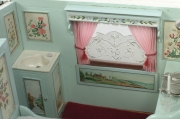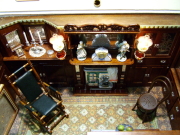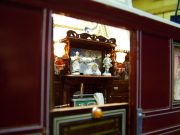1909 ORTON 22FT ROAD/RAIL WAGON
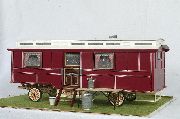 This was the first scratch built model that I made. I have used the same approach to making all of my models as I did for this one.
This was the first scratch built model that I made. I have used the same approach to making all of my models as I did for this one.
I decided to make a list of the problem areas and try to find solutions before I even started on the basic construction.
There are certain things that are important if you want to capture the true character of these wagons. The cut glass windows and mirrors, the stoves and fire surrounds, the carvings, the lighting and the painted ceilings etc.
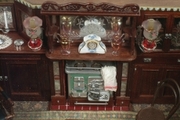 I study each problem in turn and decide (1) is it necessary that it should be there? (2) Can it be modified / stylised? (3) Can it be omitted? . I then decide whether or not I have the know how to do it myself, or if I know of anyone who could do it for me.
I study each problem in turn and decide (1) is it necessary that it should be there? (2) Can it be modified / stylised? (3) Can it be omitted? . I then decide whether or not I have the know how to do it myself, or if I know of anyone who could do it for me.
I started this model fully intending to make it as it stood at that time, including all of the modifications that had taken place over the years. I had made reasonable progress when John Pockett and Julian Wolfe persuaded me to take it back to how it looked when it was first built, with wooden wheels, sash windows etc. I eventually agreed so I had to learn how to make wooden wheels which is covered in the Techniques section. Julian had a set of wooden wheels for me to copy, that he intended to put on the wagon at some time.

I was told of another Orton wagon that was pretty original and about the same age that resided at the Hollycombe Steam Museum so I made arrangements to go and photograph it. All of the painted panels were still there, unlike Julian's wagon where many had been replaced by cut glass mirrors. The bedroom was original and gave me a good idea of how I should build my model. Armed with all of this information, I was able to progress with a degree of confidence. John Pockett sent me a copy of an early Mellor's catalogue showing what the Angel Lamps should look like.
I was fortunate to meet the 78 year old grand daughter of the original owner( Ben Howden) at a model show in Boston (Lincs) and she was able to describe in detail some of her early memories of the wagon, including the types of chairs and the candelabra that were there back in the 1920s. She sadly passed away not too long after I met her.
Details of the cut glass windows and mirrors are covered in the Techniques section along with information about the ceiling.
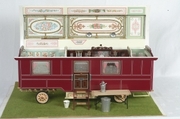 Floors in these wagons were mainly covered in lino like many houses of that period. I found a nice William Morris dolls house wallpaper, which I used and gave it three coats of clear satin varnish.
The exterior is Dulux gloss finish.
Floors in these wagons were mainly covered in lino like many houses of that period. I found a nice William Morris dolls house wallpaper, which I used and gave it three coats of clear satin varnish.
The exterior is Dulux gloss finish.

